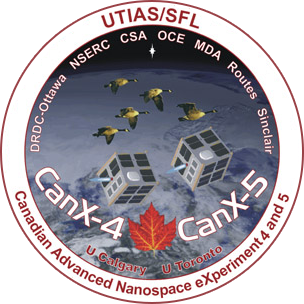Blog – Autonomous Formation Flying Enables Multi-Satellite Applications – Part 2
By Dr. Robert E. Zee

SFL was the first microspace company to develop and integrate the hardware systems and software algorithms that make autonomous formation flying a reality for micro- and nanosatellites at costs low enough to support commercial applications.
In my previous blog on this topic, I discussed how autonomous formation flight is key to certain multi-satellite geolocation and remote sensing applications. In today’s blog, I take a look at the specific technologies developed by SFL that work together to keep the satellites in their intended orbital configurations with predefined baseline separation among them.
Autonomous formation flying means the satellites communicate with each other to maintain a constellation with relative positions and spacing predetermined and sustained without assistance from ground-based commands.
SFL achieved this microspace breakthrough in technology and cost-effectiveness in 2014 with the CanX-4 and CanX-5 demonstration mission. The two 7 kg nanosatellites flew autonomously in five planned orbital configurations with separations varying from 50 meters to one kilometer. Their positional accuracy was less than a meter, and relative position knowledge was within a few centimeters.
How did it work? Over the course of many missions, we have innovated precise attitude control, modular power systems, and numerous subsystems designed specifically for smaller satellites. We devised closely coupled sets of algorithms for attitude control, navigation, and formation control of the satellites. These software solutions interact primarily with three onboard hardware systems: propulsion, differential GPS, and S-band inter-satellite radios.
Navigation is provided by onboard GPS receivers. Data from the GPS units are analyzed to determine the relative phases of reception among the formation flying satellites that determine separation distances. The GPS hardware and navigation algorithms calculate relative position to within a few centimeters on orbit.
With this information, the on-board formation control algorithms then actuate satellite propulsion systems to counteract orbital perturbations and to control relative position in the chosen orbital configuration to sub-meter accuracy. We developed an extremely precise attitude control system for small buses that enables accurate thrust to maintain position.
SFL has developed several different propulsion system technologies to maneuver small satellites in orbit, including cold and warm gas, mono-propulsion, and cylindrical Hall thruster systems for missions requiring different efficiencies and momentum change capacity. Operational formation flying missions typically require higher efficiency systems that can provide larger total momentum change over a longer mission lifetime.
Critical for the control algorithms to operate in a coordinated fashion is the inter-satellite communications link. The CanX-4 and CanX-5 satellites carried onboard S-band radios that shared data between them, most importantly their attitude and GPS location information. The sharing of information is a key enabler that allowed the satellites to stay in a precisely controlled formation.
The control algorithms on the CanX-4 and CanX-5 satellites were identical, giving each the ability to assume the role of chief or deputy. The deputy controls its position relative to the chief. In the case of more than two satellites, there would be multiple deputies all controlling their positions relative to the chief. Having identical satellites allows the roles of the satellites to be swapped, if necessary, to provide for maximum flexibility, redundancy and lifetime.
Want to read more about Autonomous Formation Flight? Check out the in-depth article on this topic published in Sat Magazine.

